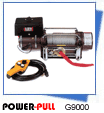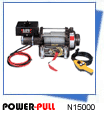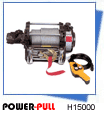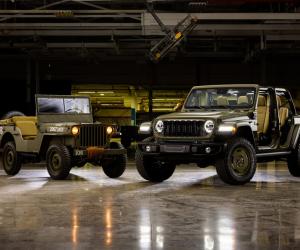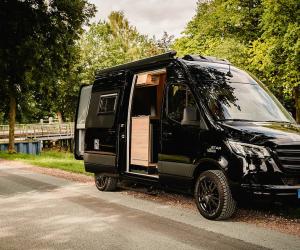Installing a Vehicle
You've had your big shiny 4x4 for a while now. It looks great in the driveway and on the school run, doesn't it? The huge spotlights you added make it look really purposeful, but it's lacking something...
Yep, you need a winch1.
So, you look through all the magazines and spot the one that's just right for you. There's a lot to choose from, including hydraulic and 'Power Take Off'2 driven, but they are only for the serious wincher. The 9000lb electrical one will allow you to pose nicely, so you order it straight away requesting next-day delivery, before 9am. You then spend the next 18 hours agonising just how to tell the wife that you've added another ?0003 to the credit card bill. You choose the moment it arrives - in fact the precise moment you are signing for it - to explain. Vehicle-mounted winches are extremely capable tools allowing both extraction of stuck vehicles and self recovery. You explain to her that if she, the kids and yourself were to get stranded in a snow drift, it could mean the difference between death and survival. At the end of the day, all you are thinking of is her and the kids. You conveniently forget to mention that badly mounting the device or operating it carelessly can prove lethal.
Installation
Most electrical winches are designed to form part of a winch and bumper combination. Sure, it's there for show, but some day you might actually use it. The two are designed to mate together allowing for the huge winching loads to be evenly distributed across the bumper. Fair enough, you're not too bothered about that, but when you offer it up to your just-washed pride and joy, you realise it won't fit. That's because the winch needs a bumper that is designed to match the vehicle it is fitted to. No expense should be spared when purchasing this additional item. You debate over fabricating your own, but decide your knowledge of mathematics and physics along with your welding skills and CAD design are sadly lacking, so you call your winch supplier and order the correct bumper. Adding another ?00 plus postage and packing4 to your credit card, you explain to your loved one that you 'had forgotten a small part'.
The winch bumper arrives the following morning. The courier driver gives you a wry grin as 'her-indoors' screams 'Small part? How much did that cost?' Try to ignore the complaints about the kids needing new shoes - this new part is crucial. It should be securely fastened to the vehicle chassis rails using the fixings supplied with the kit. The fixings are high-tensile steel bolts, rated to exceed the maximum loads the winch will be put under. No other version should be substituted or used and they should all be in the kit. If they aren't, ring up the supplier and wait for replacements. The old ones that look about the same size and are close-at-hand in the back of the shed won't do. Follow the instructions carefully and use every fixing as it is shown in the diagram. This is not flat-packed furniture; lives are at stake if you skip or bodge any part of the mounting procedure.
The winch should be electrically wired via a mechanical breaker switch, mounted in an easily and quickly accessible place, directly back to the vehicle battery. Did you order the correct cable and the switch? If you didn't, get your credit card out again but this time tell the missus you'll take her out for dinner at the weekend. Once again, bits in the back of the garage won't cut the mustard. The switch needs to be rated to cope with the continual current that will be drawn from the vehicle battery. This current can easily exceed 500 amperes at peak load, so a hefty specialised switch is required along with cable. It's fat stuff, very fat stuff and it costs about ?0 per metre. Your 4x4 is a big beast and you'll need a lot of it. It hurts, but over-order - you can't easily splice it together. While you are ordering the extra parts, have a word with your supplier about dual battery systems - two batteries, one used exclusively for the winching functions; the batteries are charged independently, all handled by some rather nifty electronics. Winches drain batteries surprisingly quickly and there is no point in recovering yourself from thigh-deep mud if you can't start the car after you escape. You guessed it, another ?00, but remember - it's for the kids. Never attempt to do away with or bypass the safety switch. Its primary purpose is to isolate power to the winch should something go wrong. It is also illegal to drive on a public carriageway with power supplied to the winch equipment5.
Getting Ready To Pre-tension The Cable
A new wire cable requires pre-tensioning. Looking at the coil of 12mm diameter steel wire, you'd be forgiven for thinking that it wouldn't stretch. It will - considerably when new, so pre-tensioning removes the 'stretch' and ensures that the cable will spool neatly on the drum. This step is vital unless you are really wealthy and have opted for plasma or synthetic rope; these versions do not need pre-tensioning. If you don't bother pre-tensioning, then you will end up with a tangled mess wrapping itself around the winch drum when you finally use it in anger. At the very least, you will be buying a new cable. Do things really well and you'll be forking out for a whole new winch.
If the winch has arrived with the cable pre-loaded, spool out all but 4-5 turns, which should remain on the drum. Use the free-spool function on the winch to achieve this efficiently. Most cables are 100 feet long (some even longer if you're rich enough for a monster winch), so you'll need plenty of space. If the cable is not pre-loaded, you'll be keen to get it on there as quickly as possible. Don't be. The first job is to make sure the winch is isolated. That's that big switch, remember? Is it off? Definitely off? Good. Put a pair of solid workman's gloves on because the cable is rough old stuff and it likes fingers6. Only now can you insert the crimped cable end into the take-up socket on the drum and wind on, by hand, 4-5 turns of cable by rotating the drum. Pay great attention to the large red arrow that indicates the cable direction. As you are doing this, take a moment to think what your fingers would have looked like should the winch have operated accidentally. Scary, isn't it? Don't attempt to load the end of the cable with the big hook on - it won't fit.
Once you've completed that, you'll need to get your vehicle ready. The engine should be running to assist the battery, the hand brake should be fully on and all wheels should be 'chocked'. There's no point in winching if the object stays put and you move instead. Drag the cable out in a straight line and attach something heavy to the other end of the cable, ie the bit with the hook - that's what it's there for. Your 30-stone mother-in-law will always be a tempting choice, but she won't be heavy enough, honestly she won't. You'll need something really heavy but something that will move as well. Can't think of anything? Can't find anything in the garage? What about all your mates you invited round for the afternoon to help7, can they not think of anything? Well done that man - Yes! You need a car, a big one. Get matey boy number one to sit in his 4x4, preferably with his foot on the brake. That'll make it sufficiently heavy.
If you are Billy-no-mates, don't ever be tempted to pre-tension by winching your vehicle towards a static object, even if it seems like a good idea at the time. Your car is heavy and that lamp-post is solid enough, so that's the same as pulling another object toward your car, right? Wrong, lamp-posts are not solid - they bend easily8. And they're expensive. You also need to be able to see what is going on around the winch drum, which means you'll get run over and that's not clever. Remember also that your neighbours will be popping their heads over their garden hedges like meerkats. They'll quite happily tell the local bobby it was you that bent the lamp-post, or the coroner how you died.
The Fun Bit
Once you have everything set up, then the fun can begin. You did remember to thread the cable through the roller fairlead9 didn't you? If you didn't, you'll have another opportunity to manually wind 4-5 turns on the drum.
Connect the winch hand-control to the winch solenoid box by plugging it in. If the winch salesman has done his job, you'll actually be the proud owner of a flashy radio remote system, rather than the standard wire-based one10 so show this excitedly to all your mates and accept their approval. Grab yourself a rubber mallet and begin to gently winch in. If the motor makes a grinding noise and nothing happens, you've forgotten to engage the winch gearbox after free-spooling the cable. Do so, by yanking the shiny lever marked 'engage' upwards - it really helps. If the cable goes slack, you are 'paying out' rather than winching in so select the other button - there are only two buttons, in or out. How difficult can it be?
As you winch in, watch the cable spooling on the drum. It needs to lie neatly against the previous winding. If it goes off-course, stop winching and use the mallet to tap the cable, forcing it over into position. Be gentle, but firm. If it won't budge, don't bash it; simply pay out a little cable and start again. Repeat this until you have consumed all the cable and have it neatly stacked on five layers.
The Not-so-fun Bit
Great, wasn't it? Now you get to do it all again. Five or six times again. That stretch won't go away without some effort. If matey boy number one is moaning about his aching foot, tell him not to be such a girl and replace him with matey boy number two. You'll find that as you repeat things the cable will naturally find its way and the whole operation becomes continuous and smooth. Finally, attach the hook to its anchor point and winch in the last few inches, causing everything to lock tightly. This will prevent the cable becoming loose and will help it to 'bed' over the next few days.
Check and re-check all the fixings, ensuring they are tight and secure. Pack away your tools and hop in the shower. You are taking the wife out, remember?
Over dinner, no doubt you'll remember that you should have informed the insurance company about your new additions. All that weight on the nose will affect the handling and lessens the 'pedestrian-friendly' zone at the front of the car. OK, there never was one - it's a 4x4 after all, but insurance companies like to charge for this sort of thing, so that's another chunk of cash gone. That's if you are lucky enough to have a company that will accept the modifications. Many won't. Try explaining that to the love of your life when the credit card bill comes in.
Safety
A typical winch will pull in the region of 9000-12000lbs. That's a huge load. If something breaks, or comes loose, the results can be catastrophic. Always follow the manufacturers' instructions and recommendations and observe the following points.
Always wear hand and eye protection. Never let the cable slip through your hands.
Never step over a tensioned cable. If it snaps, serious injury will result.
Keep all spectators well away. Keep all operators away from the moving cable and vehicle.
Inspect all equipment before use. Damaged or frayed cables should be disposed of.
Nominate a winch operator. Only they call the instructions.
Keep the remote control lead well away from the winch drum.
Think safety at all times.
--------------------------------------------------------------------------------
1 If at this point you are thinking 'What the heck is a winch?' this is the wrong type of Guide Entry for you. The 'Back' button in your browser will alleviate the problem. Alternatively, click the link.
2 Or PTO; a winch mechanically driven from the vehicle's transfer gearbox.
3 This price was correct at the time of writing - May 2006. If you are reading this in 2050, the price will still be correct. This type of winch has always been ?000.
4 Yes, it is ?5. These things are heavy!
5 Imagine driving down a motorway at 70mph when the cable decides to 'pay out'. It gets messy - that's why it's illegal.
6 Namby-pamby driving gloves are not recommended. They'll tear easily and you'll look incredibly stupid.
7 Come on, admit it - you just wanted to show off your new toy didn't you?
8 It's a design thing. Cars and lamp-posts don't see eye-to-eye in crashes, so they are made to buckle easily.
9 It's the funny-looking four-roller device (two horizontal, two vertical in a post-box layout) that helps the cable spool easily.
10 Yep, another ?00.



